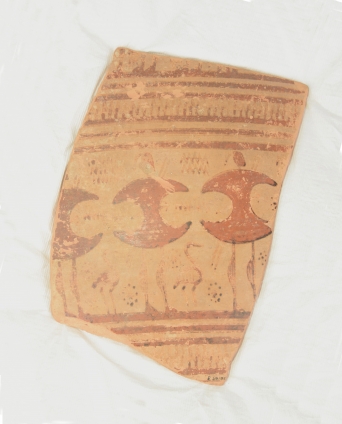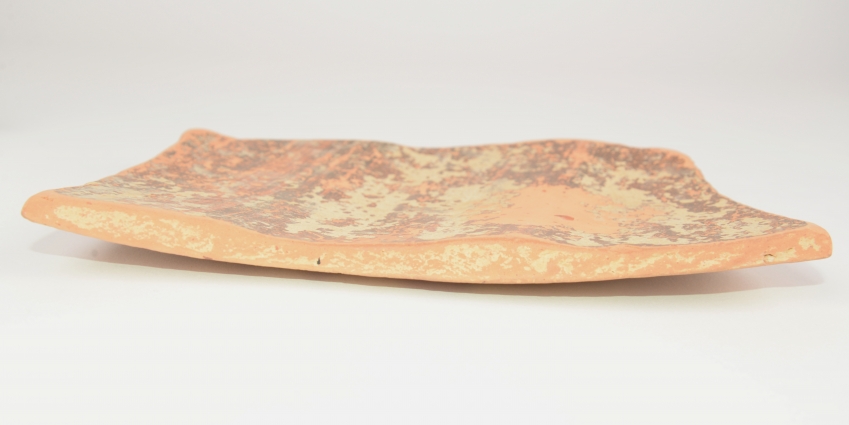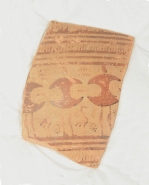Sherd, E48.195
Physical Description
A fragment from a large funerary urn (pedestalled krater). Urns such as this were made to stand on graves. Funerals are usually depicted although battle scenes such as this also appear. Warriors carrying shields, swords and spears are shown in procession. The storklike birds, zigzags and dot-rosettes merely fill in space.
Attributed to an artist now known as the Hirschfeld Painter.
750-735 BC.
Published in Corpus Vasorum Antiquorum; Mr J Green, Union Academique Internationale; 1979 Plate 5
Attributed to an artist now known as the Hirschfeld Painter.
750-735 BC.
Published in Corpus Vasorum Antiquorum; Mr J Green, Union Academique Internationale; 1979 Plate 5
Research Notes
“This fragment comes from a large open vase (the inside surface is glazed), perhaps a funeral krater like the one in Sydney (Handbook to the Nicholson Museum, Fig. 48 on p.244). It shows three warriors, part of a procession which probably once extended right around the vase. Each covers himself with his shield; neither body nor arms are visible but the head is seen above the shield-rim. It is helmeted, as appears from the long thin plume that drops to the rear, but no features are shown. Below each shield are two legs, straight, vertical, parallel and disconnected. The calves are most prominently shown, perhaps to indicate that the warriors. like the Achaeans of Homer, are 'well-greaved.' Each man carries two spears sloping diagonally across his body; their points appear above the shields to the right and their butts below them to the left. The form of the shield is curious. The upper and lower rims are convex, but a large round piece seems to have been cut out of each of the vertical edges, so that the shield looks almost like a letter H laid on its side. This strange shape is probably the result of fastening a piece of ox-hide to a wooden framework consisting of an upright with a horizontal cross piece attached to each end. When the hide dried and shrank, the free ends of the cross-pieces would have been drawn inwards, thus making the convex curves of the top and bottom rims, and the sides, which had no frame-work to stiffen them, would be drawn in still further towards the centre until they seem to have been cut away.
Warriors with this equipment fought as individuals, not in the close-ordered ranks of the later phalanx. They are often shown riding in chariots (as on the Nicholson Museum krater). They carry two spears because their spears are for throwing (as often in the Iliad).
Each of the warriors is followed by a long-necked, stiff jointed water-bird, perhaps a crane. These have nothing to do with the men; they are merely to fill up blank spaces, as are the dot-rosettes on either side of them and the rows of horizontal wavy lines between the men's heads.
The wide zone which the warriors occupy is bounded above and below by narrow zones consisting of wavy lines between groups of three horizontal bands. At the top of the fragment are the feet of more figures - perhaps mourners - facing to the left.” —Dr Daniel Osland
Warriors with this equipment fought as individuals, not in the close-ordered ranks of the later phalanx. They are often shown riding in chariots (as on the Nicholson Museum krater). They carry two spears because their spears are for throwing (as often in the Iliad).
Each of the warriors is followed by a long-necked, stiff jointed water-bird, perhaps a crane. These have nothing to do with the men; they are merely to fill up blank spaces, as are the dot-rosettes on either side of them and the rows of horizontal wavy lines between the men's heads.
The wide zone which the warriors occupy is bounded above and below by narrow zones consisting of wavy lines between groups of three horizontal bands. At the top of the fragment are the feet of more figures - perhaps mourners - facing to the left.” —Dr Daniel Osland
References
Handbook to the Greek Vases in the Otago Museum; Mr J K AndersonCorpus Vasorum Antiquorum; Mr J Green, Union Academique Internationale
Provenance
Measurements
Maximum Height: 253mmAll Rights Reserved




